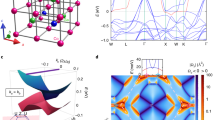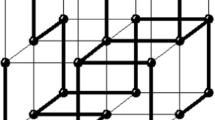Abstract
It is known that critical fluctuations can change the effective anisotropy of a cubic ferromagnet near the Curie point. If the crystal undergoes a phase transition into the orthorhombic phase and the initial anisotropy is not too strong, then the effective anisotropy acquires the universal value A* = v*/u* at T c, where u* and v* are the coordinates of the cubic fixed point of the renormalization group equations in the scaling equation of state and expressions for nonlinear susceptibilities. Using the pseudo-ϵ-expansion method, we find the numerical value of the anisotropy parameter A at the critical point. Padé resummation of the six-loop pseudo-ϵ-expansions for u*, v*, and A* leads to the estimate A* = 0.13 ± 0.01, giving evidence that observation of anisotropic critical behavior of cubic ferromagnets in physical and computer experiments is entirely possible.
Similar content being viewed by others
References
K. G. Wilson and M. E. Fisher, “Critical exponents in 3.99 dimensions,” Phys. Rev. Lett., 28, 240–243 (1972).
D. J. Wallace, “Critical behaviour of anisotropic cubic systems,” J. Phys. C, 6, 1390–1404 (1973).
I. J. Ketley and D. J. Wallace, “A modified epsilon expansion for a Hamiltonian with cubic point-group symmetry,” J. Phys. A: Math. Gen., 6, 1667–1678 (1973).
I. F. Lyuksyutov and V. L. Pokrovskii, “First-order phase transitions in systems with cubic anisotropy,” JETP Lett., 21, 9–11 (1975).
A. Aharony, “Critical behavior of anisotropic cubic systems,” Phys. Rev. B, 8, 4270–4273 (1973).
A. I. Sokolov, Soviet Phys. Solid State, 19, 433–440 (1977).
K. E. Newman and E. K. Riedel, “Cubic N-vector model and randomly dilute Ising model in general dimensions,” Phys. Rev. B, 25, 264–280 (1982); Erratum, 30, 2924.
M. Ferer, J. P. Van Dyke, and W. J. Camp, “Effect of a cubic crystal field on the critical behavior of a 3D model with Heisenberg exchange coupling: A high-temperature series investigation,” Phys. Rev. B, 23, 2367–2373 (1981).
M. Tissier, D. Mouhanna, J. Vidal, and B. Delamotte, “Randomly dilute Ising model: A nonperturbative approach,” Phys. Rev. B, 65, 140402 (2002); arXiv:cond-mat/0109176v3 (2001).
I. O. Maier and A. I. Sokolov, “On the critical behavior of cubic crytals under structural phase transitions [in Russian],” Izv. AN SSSR Ser. Fiz., 51, 2103–2106 (1987)
I. O. Maier, A. I. Sokolov, “Is a cubic crystal ‘isotropic’ in the critical point?” Ferroelectrics Lett. Sect., 9, 95–98 (1988).
N. A. Shpot, “Critical behavior of the mn-component field model in three dimensions II. Three-loop results,” Phys. Lett. A, 142, 474–478 (1989).
I. O. Mayer, A. I. Sokolov, and B. N. Shalaev, “Critical exponents for cubic and impure uniaxial crystals: Most accurate (ϕ) theoretical values,” Ferroelectrics, 95, 93–96 (1989).
D. V. Pakhnin and A. I. Sokolov, “Five-loop renormalization-group expansions for the three-dimensional nvector cubic model and critical exponents for impure Ising systems,” Phys. Rev. B, 61, 15130–15135 (2000); arXiv:cond-mat/9912071v3 (1999).
J. M. Carmona, A. Pelissetto, and E. Vicari, “N-component Ginzburg–Landau Hamiltonian with cubic anisotropy: A six-loop study,” Phys. Rev. B, 61, 15136–15151 (2000); arXiv:cond-mat/9912115v2 (1999).
H. Kleinert and V. Schulte-Frohlinde, “Exact five-loop renormalization group functions of ϕ4-theory with O(N)-symmetric and cubic interactions: Critical exponents up to e5,” Phys. Lett. B, 342, 284–296 (1995); arXiv:condmat/9503038v1 (1995).
H. Kleinert and S. Thoms, “Large-order behavior of a two-coupling-constant ϕ4 theory with cubic anisotropy,” Phys. Rev. D, 52, 5926–5943 (1995); arXiv:hep-th/9508172v1 (1995).
H. Kleinert, S. Thoms, and V. Schulte-Frohlinde, “Stability of a three-dimensional cubic fixed point in the two-coupling-constant ϕ4 theory,” Phys. Rev. B, 56, 14428–14434 (1997); arXiv:quant-ph/9611050v1 (1996).
B. N. Shalaev, S. A. Antonenko, and A. I. Sokolov, “Five-loop \(\sqrt \varepsilon \)-expansion for random Ising model and marginal spin dimensionality for cubic systems,” Phys. Lett. A, 230, 105–110 (1997); arXiv:cond-mat/9803388v1 (1998).
R. Folk, Yu. Holovatch, and T. Yavors’kii, “Effective and asymptotic critical exponents of a weakly diluted quenched Ising model: Three-dimensional approach versus \(\sqrt \varepsilon \) expansion,” Phys. Rev. B, 61, 15114–15129 (2000); arXiv:cond-mat/9909121v2 (1999).
R. Folk, Yu. Holovatch, and T. Yavors’kii, “Pseudo-e expansion of six-loop renormalization-group functions of an anisotropic cubic model,” Phys. Rev. B, 62, 12195–12200 (2000); Erratum, 63, 189901; arXiv:cond-mat/0003216v2 (2000).
K. B. Varnashev, “Stability of a cubic fixed point in three dimensions: Critical exponents for generic N,” Phys. Rev. B, 61, 14660–14674 (2000); arXiv:cond-mat/9909087v4 (1999).
A. Pelissetto and E. Vicari, “Critical phenomena and renormalization-group theory,” Phys. Rep., 368, 549–727 (2002); arXiv:cond-mat/0012164v6 (2000).
R. Guida and J. Zinn–Justin, “Critical exponents of the N-vector model,” J. Phys. A: Math. Gen., 31, 8103–8121 (1998); arXiv:cond-mat/9803240v3 (1998).
D. V. Pakhnin and A. I. Sokolov, “Renormalization group and nonlinear susceptibilities of cubic ferromagnets at criticality,” Phys. Rev. B, 64, 094407 (2001); arXiv:cond-mat/0102368v3 (2001).
J. C. Le Guillou and J. Zinn-Justin, “Critical exponents from field theory,” Phys. Rev. B, 21, 3976–3998 (1980).
Yu. Holovatch, D. Ivaneiko, and B. Delamotte, “On the criticality of frustrated spin systems with noncollinear order,” J. Phys. A: Math. Gen., 37, 3569–3575 (2004); arXiv:cond-mat/0312260v1 (2003).
A. I. Sokolov and M. A. Nikitina, “Pseudo-e expansion and renormalized coupling constants at criticality,” Phys. Rev. E, 89, 052127 (2014); arXiv:1402.3531v2 [cond-mat.stat-mech] (2014).
A. I. Sokolov and M. A. Nikitina, “Fisher exponent from pseudo-e expansion,” Phys. Rev. Es, 90, 012102 (2014); arXiv:1402.3894v2 [cond-mat.stat-mech] (2014).
M. A. Nikitina and A. I. Sokolov, “Critical exponents and the pseudo-e-expansion,” Theor. Math. Phys., 186, 192–204 (2016); arXiv:1602.08681v1 [cond-mat.stat-mech] (2016).
A. I. Sokolov and M. A. Nikitina, “Pseudo-expansion and critical exponents of superfluid helium,” Phys. A, 444, 177–181 (2016); arXiv:1402.4318v3 [cond-mat.stat-mech] (2014).
P. Calabrese, E. V. Orlov, D. V. Pakhnin, and A. I. Sokolov, “Critical behavior of two-dimensional cubic and MN models in the five-loop renormalization group approximation,” Phys. Rev. B, 70, 094425 (2004); arXiv:cond-mat/0405432v1 (2004).
P. Calabrese and P. Parruccini, “Harmonic crossover exponents in O(n) models with the pseudo-e expansion approach,” Phys. Rev. B, 71, 064416 (2005); arXiv:cond-mat/0411027v2 (2004).
A. I. Sokolov, “Pseudo-epsilon expansion and the two-dimensional Ising model,” Phys. Sol. State, 47, 2144–2147 (2005); arXiv:cond-mat/0510088v2 (2005).
A. I. Sokolov, “Phase transitions in two dimensions and multiloop renormalization group expansions,” Theor. Math. Phys., 176, 948–955 (2013).
M. A. Nikitina and A. I. Sokolov, “Critical exponents in two dimensions and pseudo-e expansion,” Phys. Rev. E, 89, 042146 (2014); arXiv:1312.1062v3 [cond-mat.stat-mech] (2013).
Author information
Authors and Affiliations
Corresponding author
Additional information
The research of A. Kudlis was supported by a grant from the Russian Science Foundation (Project No. 16-11-10218).
The research of A. I. Sokolov was supported by the Russian Foundation for Basic Research (Grant No. 15-02-04687).
Prepared from an English manuscript submitted by the authors; for the Russian version, see Teoreticheskaya i Matematicheskaya Fizika, Vol. 190, No. 2, pp. 344–353, February, 2017.
Rights and permissions
About this article
Cite this article
Kudlis, A., Sokolov, A.I. Field theory and anisotropy of a cubic ferromagnet near the Curie point. Theor Math Phys 190, 295–302 (2017). https://doi.org/10.1134/S0040577917020106
Published:
Issue Date:
DOI: https://doi.org/10.1134/S0040577917020106




